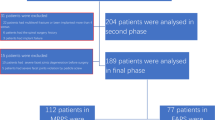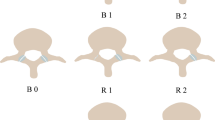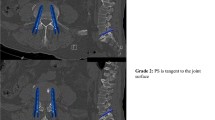Abstract
Purpose
This retrospective study determined the rate of osteoarthritis and spontaneous facet joint fusion and analyzed risk factors related to patient characteristics, fracture type or surgical technique on pre- and postoperative CT after percutaneous instrumentation in thoracolumbar fractures.
Methods
1050 facet joints adjacent to screws in 148 patients (15–85 years) with thoracolumbar fractures were analyzed with an average time between CTs of 12.3 months. Screw diameters, lengths and cement augmentation were recorded. Facet joint violation by screw trajectory and by insertion depth was classified in three grades. Pre- and postoperative osteoarthritis was graded as absent, minor or severe and postoperative facet joint fusion as absent, partial or complete.
Results
The facet violation rate was moderate in 15.4% and severe in 0.6% according to screw trajectory, and 11.0 and 0.6%, respectively, according to insertion depth. Osteoarthritis was preoperatively rated moderate in 9.6% and severe in 1.2%. A progression was evidenced in 79 facet joints (7.5%). Screw cement augmentation was the main predictive factor (p < 0.0001). Partial fusion was evidenced in 2.6% and complete fusion in 1% of facet joints. Risk factors were: BMI (p = 0.0002), age (p = 0.0013), preoperative osteoarthritis (p = 0.0005), time between 2 CTs (p = 0.0001), B-type fractures (p = 0.0005), concomitant anterior fusion (p = 0.0034).
Conclusions
Occurrence or worsening of osteoarthritis was mainly observed in elderly patients with cement-augmented screws and spontaneous facet fusion in elderly patients with high BMI and preoperative osteoarthritis, or in anteriorly fused B-type injuries. Thus, percutaneous instrumentation can safely be removed after fracture consolidation in younger patients while preserving facet joints.





Similar content being viewed by others
References
Court C, Vincent C (2012) Percutaneous fixation of thoracolumbar fractures: current concepts. Orthop Traumatol Surg Res 98:900–909
Scheer JK, Bakhsheshian J, Fakurnejad S et al (2015) Evidence-based medicine of traumatic thoracolumbar burst fractures: a systematic review of operative management across 20 years. Global Spine J 5:73–82
Gnanenthiran SR, Adie S, Harris IA (2012) Non-operative versus operative treatment for thoracolumbar burst fractures without neurologic deficit: a meta-analysis. Clin Orthop Relat Res 470:567–577
Shen WJ, Liu TJ, Shen YS (2001) Non-operative treatment versus posterior fixation for thoracolumbar junction burst fractures without neurological deficit. Spine (Phila Pa 1976) 26:1038–1045
Wood K, Buttermann G, Mehbod A et al (2003) Operative compared with non-operative treatment of a thoracolumbar burst fracture without neurological deficit. A prospective, randomized study. J Bone Jt Surg Am 85:773–781
Vanek P, Bradac O, Konopkova R et al (2014) Treatment of thoracolumbar trauma by short-segment percutaneous transpedicular screw instrumentation: prospective comparative study with a minimum 2-year follow-up. J Neurosurg Spine 20:150–156
Lee JK, Jang JW, Kim TW et al (2013) Percutaneous short-segment pedicle screw placement without fusion in the treatment of thoracolumbar burst fractures: is it effective? Comparative study with open short-segment pedicle screw fixation with posterolateral fusion. Acta Neurochir 155:2305–2312
Fuentes S, Blondel B, Metellus P et al (2010) Percutaneous kyphoplasty and pedicle screw fixation for the management of thoraco-lumbar burst fractures. Eur Spine J 19:1281–1287
Rahamimov N, Mulla H, Shani A et al (2012) Percutaneous augmented instrumentation of unstable thoracolumbar burst fractures. Eur Spine J 21:850–854
Eck JC (2011) Minimal invasive corpectomy and posterior stabilization for lumbar burst fracture. Spine J 11:904–908
Charles YP, Walter A, Schuller S et al (2012) Thoracolumbar fracture reduction by percutaneous in situ contouring. Eur Spine J 21:2214–2221
Takami M, Yamada H, Nohda K et al (2014) A minimally invasive surgery combining temporary percutaneous pedicle screw fixation without fusion and vertebroplasty with transpedicular intracorporeal hydroxyapatite blocks grafting for fresh thoracolumbar burst fractures: prospective study. Eur J Orthop Surg Traumatol 24:159–165
Proietti L, Scaramuzzo L, Schirò GR et al (2015) Degenerative facet joint changes in lumbar percutaneous pedicle screw fixation without fusion. Orthop Traumatol Surg Res 101:375–379
Magerl F, Aebi M, Gertzbein SD et al (1994) A comprehensive classification of thoracic and lumbar injuries. Eur Spine J 3:184–201
Wild MH, Glees M, Plieschnegger C et al (2007) Five-year follow-up examination after purely minimally invasive percutaneously and conventionally treated patients. Arch Orthop Trauma Surg 127:335–343
Heintel TM, Berglehner A, Meffert R (2013) Accuracy of percutaneous pedicle screws for thoracic and lumbar spine fractures: a prospective trial. Eur Spine J 22:495–502
Park P, Garton HJ, Gala VC et al (2004) Adjacent segment disease after lumbar or lumbosacral fusion: review of the literature. Spine (Phila Pa 1976) 29:1938–1944
Babu R, Park JG, Mehta AI et al (2012) Comparison of superior-level facet joint violations during open and percutaneous pedicle screw placement. Neurosurgery 71:962–970
Knox JB, Dai JM 3rd, Orchowski JR (2011) Superior segment facet joint violation and cortical violation after minimally invasive pedicle screw placement. Spine J 11:213–217
Park Y, Ha JW, Lee YT et al (2011) Cranial facet joint violations by percutaneously placed pedicle screws adjacent to a minimally invasive lumbar spinal fusion. Spine J 11:295–302
Jones-Quaidoo SM, Djurasovic M, Owens RK 2nd et al (2013) Superior articulating facet violation: percutaneous versus open techniques. J Neurosurg Spine 18:593–597
Wang L, Wang Y, Yu B et al (2015) Comparison of cranial facet joint violation rate between percutaneous and open pedicle screw placement: a systematic review and meta-analysis. Medicine (Balitmore) 94:e504
Tian W, Xu Y, Liu B et al (2014) Lumbar spine superior-level facet joint violations: percutaneous versus open pedicle screw insertion using intraoperative 3-dimensional computer-assisted navigation. Chin Med J (Engl) 127:3852–3856
Yson SC, Sembrano JN, Sanders PC et al (2013) Comparison of cranial facet joint violation rates between open and percutaneous pedicle screw placement using intraoperative 3-DCT(O-arm) computer navigation. Spine (Phila Pa 1976) 38:E251–E258
Ohba T, Ebata S, Fujita K et al (2016) Percutaneous pedicle screw placements: accuracy and rates of cranial facet joint violation using conventional fluoroscopy compared with intraoperative three-dimensional computed tomography computer navigation. Eur Spine J 25:1775–1780
Choma TJ, Frevert WF, Carson WL et al (2011) Biomechanical analysis of pedicle screws in osteoporotic bone with bioactive cement augmentation using in vivo multicomponent loading. Spine (Phila Pa 1976) 36:452–454
Charles YP, Pelletier H, Hydier P et al (2015) Pullout characteristics of percutaneous pedicle screws with different cement augmentation methods in elderly spines: an in vitro biomechanical study. Orthop Traumatol Surg Res 101:369–374
Bostelmann R, Keiler A, Steiger HJ et al (2015) Effect of augmentation techniques on the failure of pedicle screws under cranio-caudal cyclic loading. Eur Spine J. doi:10.1007/s00586-015-3904-3
Vaccaro AR, Oner C, Kepler CK et al (2013) AOSpine thoracolumbar spine injury classification system: fracture description, neurological status, and key modifiers. Spine (Phila Pa 1976) 38:2028–2037
Vaccaro AR, Schroeder GD, Kepler CK et al (2016) The surgical algorithm for the AOSpine thoracolumbar spine injury classification system. Eur Spine J 25:1087–1094
Author information
Authors and Affiliations
Corresponding author
Ethics declarations
Conflict of interest
All authors declared that they have no potential conflict of interest.
Funding
No source of funding for this study.
Rights and permissions
About this article
Cite this article
Tromme, A., Charles, Y.P., Schuller, S. et al. Osteoarthritis and spontaneous fusion of facet joints after percutaneous instrumentation in thoracolumbar fractures. Eur Spine J 28, 1121–1129 (2019). https://doi.org/10.1007/s00586-017-5173-9
Received:
Revised:
Accepted:
Published:
Issue Date:
DOI: https://doi.org/10.1007/s00586-017-5173-9




